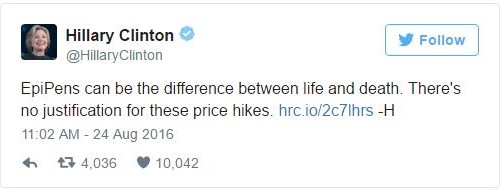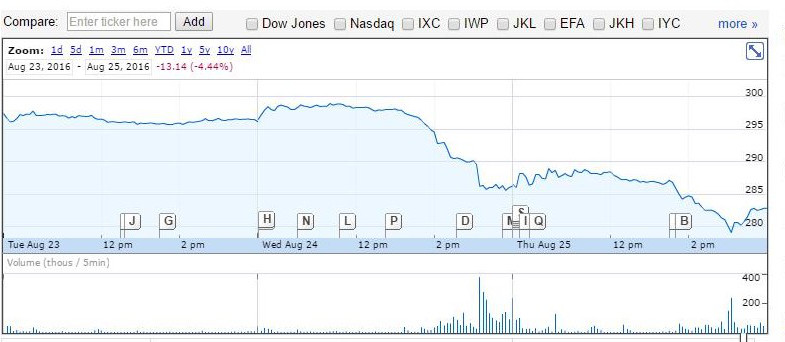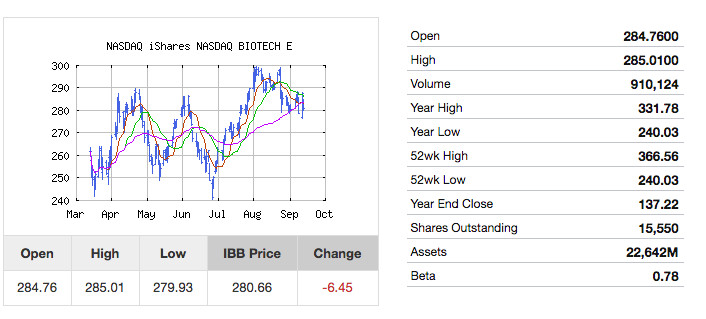INO Health & Biotech Stock Guide
Preview Issue #2 - Sept 21st, 2016
BIOTECH, HEALTH & PHARMA NEWS
Hillary Clinton has thrusted the drug pricing debate onto center stage once again after calling out Mylan for its aggressive price increases over the past decade for its EpiPen. The EpiPen uses an auto-injection of epinephrine to treat severe allergic reactions, particularly deadly in school age children. Mylan acquired the product in 2007, and the “list” price increased from $100 in 2008 to its current “list” price of ~$600. Hillary Clinton was quoted as stating:
"That's outrageous — and it's just the latest troubling example of a company taking advantage of its consumers," and "It's wrong when drug companies put profits ahead of patients, raising prices without justifying the value behind them."
After Hillary Clinton’s tweet, The iShares Nasdaq Biotechnology ETF (Ticker: IBB) sold off ~5% within minutes and moved from $299 to $279 per share by the next day or 6.7% over a two day period (Figures 1 and 2).

Figure 1 – Hillary Clinton’s tweet in response to the latest EpiPen price increase.

Figure 2 – Correlation between Hillary Clinton’s tweet and the subsequent sell-off of the biotech cohort IBB.
These types of political attacks have plagued the biotech sector for the better part of a year now and will likely continue to do so until there’s clarity in terms of the presidential cycle being complete. Be cautious of continued volatility within the sector due to extraneous political rhetoric regarding the drug pricing debate.
FEATURED STOCK / ETF

WHAT'S NEXT
Walgreens, the nation’s largest drugstore chain made a $9.4 billion bid to acquire Rite Aid, the nation’s third largest drugstore chain in October of 2015. Walgreens has been working closely with increasingly hesitant federal regulators to get this acquisition approved. It was recently announced that Walgreens believes that it will probably have to divest more stores than previously expected to appease antitrust concerns. To that end, Walgreens will probably have to divest more than 500 stores. The divestiture may be up to 1,000 stores if needed however Walgreens said it still expects to divest fewer. Federal regulators have already sued to block two multibillion-dollar health insurance mergers this year between Anthem and Cigna and Aetna and Humana.
Walgreens currently runs 8,173 U.S. stores and this figure could climb to 12,000 with the acquisition of Rite Aid. Ostensibly, the merger would give Walgreens increased negotiating power with drug manufactures and other suppliers and expand its geographical footprint. If the merger is successful, Walgreens and CVS Health would dominate the pharmacy space with potentially 12,000 and 9,600 retail pharmacies, respectively.
INDUSTRY OUTLOOK
The drug pricing debate continues to be at the forefront of politicians and patients alike. Mylan CEO Heather Bresch countered the recent criticism her company received over the price increases for its EpiPen. She pointed the finger at the supply chain and its complexities. There may be some truth to that statement, Mylan took a 31-percent price increase on its EpiPen in 2015, while selling 7 percent more pens that year however Mylan's net revenue on the EpiPen actually fell 1 percent. Along the drug supply chain, each middleman receives a portion of the money charged for the drug throughout the supply chain. To some extent, Mylan is incentivized to increase the list price of its medicines, so Mylan can then rebate money to middlemen throughout the drug-supply chain.
It’s a misconception that drug companies are pocketing the “list” price money. The Pharmacy-Benefit Manager (PBM) and drug distribution companies have the power to negotiate lower prices as a result of their scale and user base. Thus only a fraction of the list price money is returned to the drug maker and in Mylan’s case they only net 45% of the list price. Mylan broke out the economics of the EpiPen supply chain. Out of the $608 list price, it said it nets only $274 per EpiPen 2-Pak, after rebates to PBMs and cuts taken by distributors and pharmacies. The political attacks are unwarranted in my opinion based on that drug supply chain dynamics and thus the net capture of the “list” price. In terms of the overall cost to the healthcare system, drugs comprise less than 10% of the cost structure thus drug prices are not necessarily the culprit as the media suggests. As candidates threaten drug companies with containing the costs of drugs, these actions will continue to negatively impact healthcare and biotech stocks in particular. As the political cycle comes to an end many of these headwinds will be removed and will likely allow the cohort to move higher.
ABOUT THE EDITOR - Noah Kiedrowski
I am biotechnology professional with a diverse scientific background and detailed knowledge in many therapeutic areas such as monoclonal antibodies, immunotherapies and antivirals. I have a personal interest in finance, investing, trading and global markets. My analysis is focused on stocks and exchange traded funds (ETFs) while exploring niche opportunities such as derivative trading via options. This newsletter is intended to provide investors with the latest developments and trends regarding the overall healthcare sector with a biotechnology emphasis. I'll be highlighting sector trends, merger and acquisition activity, noteworthy current events, political developments and drug approvals. My focus will be centered on well-established mid-cap and large-cap companies as well as utilizing appropriate ETFs as proxies for sector trends. This is a bi-monthly newsletter service that reflects my own opinions and analyses. This newsletter is not intended to be a recommendation to buy or sell any stock or ETF mentioned. I am not a professional financial advisor or tax professional, rather an individual investor who analyzes investment strategies and disseminates my analyses. I encourage all investors to conduct their own research and due diligence prior to investing.
---
This bi-monthly newsletter service reflects the opinions and analyses of INO Contributor, Noah Kiedrowski. This newsletter is not intended to be a recommendation to buy or sell any stock or ETF mentioned. Kiedrowski is not a professional financial advisor or tax professional, rather an individual investor who analyzes investment strategies and disseminates his own analyses. All traders and investors should conduct their own research and due diligence prior to investing.
